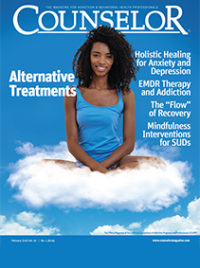Share
 In my previous column I discussed the daily challenges shared by clients in co-occurring disorders treatment groups that I regularly conduct in an intensive outpatient program (IOP). In this column, I discuss an issue that often arises and perplexes these clients: experiencing persistent, residual, or chronic symptoms related to their psychiatric disorders. Clients also experience symptoms of their substance use disorders (SUDs) that they must manage to sustain their recovery.
In my previous column I discussed the daily challenges shared by clients in co-occurring disorders treatment groups that I regularly conduct in an intensive outpatient program (IOP). In this column, I discuss an issue that often arises and perplexes these clients: experiencing persistent, residual, or chronic symptoms related to their psychiatric disorders. Clients also experience symptoms of their substance use disorders (SUDs) that they must manage to sustain their recovery.
Clients struggle with the notion that not all psychiatric symptoms will remit. They sometimes have unrealistic expectations of what they can gain from treatment. I am reminded of an elderly client with a long history of an anxiety disorder, a depressive disorder, and a severe alcohol use disorder who told group members her goal—in addition to staying sober from alcohol use—was to “no longer feel depressed or anxious.” Although this was an understandable statement given how long she had these multiple disorders and suffered from some anxiety or depressive symptoms that never totally remitted, it was not realistic for her to expect total remission. What actually happened in this case is that she initiated abstinence and sustained long-term sobriety from her alcohol use disorder by participating in therapy and attending AA regularly; improved her anxiety and depressive symptoms moderately with the use of medications and therapy; and improved the quality of her life considerably as a result of focusing on both types of disorders. Improved functioning and a better quality of life are good outcomes even if clients experience some persistent symptoms.
Recurrent and Chronic Psychiatric Disorders
Many psychiatric disorders are recurrent, persistent, or chronic conditions that affect clients for years or even throughout their lives. Some symptoms may remit totally, and others may remit partially or become less severe or bothersome to clients. The term “serious and persistent mental illness” is often used for clients with psychiatric conditions such as recurrent mood disorders, schizophrenia or other psychotic disorders, or borderline personality disorder.
Part of “illness management” with any medical, psychiatric, or substance abuse disorder is learning to cope with symptoms of the disorder during episodes of exacerbation of active illness, or during periods of recovery when improvements are experienced but some symptoms remain (Gingerich & Mueser, 2015). Managing persistent, residual, or chronic symptoms should be part of clients’ treatment plans so that they are not demoralized when symptoms do not totally remit, or if some worsen over time (Liberman, Wallace, Eckman, & Wirshing, 1988). Improvement occurs when symptoms decrease in severity and adverse impact on clients’ lives, and they function better or feel enhanced quality of life. Many clients have learned to live and cope with their persistent psychiatric symptoms.
Substance Use Disorders (SUDs)
According to DSM-5, one of the eleven diagnostic symptoms of a SUD is craving, or a strong desire or urge to use alcohol or drugs (APA, 2013). Cravings can persist even after achieving and sustaining remission from all other SUD symptoms. Learning to manage cravings during periods of recovery is an important recovery task if clients are to sustain sobriety. Cravings can be triggered by many internal or external stimuli even after clients have been substance free for a substantial period of time. Related to cravings are thoughts or obsessions of using substances, which can also be experienced any time during recovery.
Clients with co-occurring SUDs, especially moderate or more severe types, often struggle with motivation to change. When they experience a strong craving or urge, they are at risk to use if they do not use active coping strategies to manage these.
Managing Persistent Symptoms of a Psychiatric Illness
Reviews of clinical trials and meta-analyses of multiple studies on the outcomes of treatment of psychiatric illness or co-occurring disorders document many positive effects of treatment and offer many strategies to help clients manage their disorders (Corrigan, Mueser, Bond, Drake, & Solomon, 2009; Daley & Douaihy, 2015; Smith et al., 2010; Gingerich & Mueser, 2015; Liberman et al., 1988; Mueser, Noordsy, Drake, & Smith, 2003; Ralph & Corrigan, 2005). Positive outcomes include improvements in psychiatric symptoms and functioning, reduced rates of recurrence of illness, reduced rates of psychiatric hospitalization, less substance use, and improvements in psychosocial functioning. Treatment helps clients learn strategies to manage acute and persistent symptoms of their psychiatric disorders, and stop or reduce their substance use.
Following are steps to help clients manage their persistent or chronic psychiatric symptoms. A one-page monthly calendar can be used to write select symptoms and daily ratings of it so that clients can keep track of the “big picture” and see changes in symptoms over time. There are different implications for symptoms that worsen moderately for just a few days compared to symptoms that worsen significantly for a week or longer.
Identify Symptoms
Clients identify persistent symptoms of their mental illness to watch and monitor. Monitoring can be daily at first then less often as recovery progresses. Clients should start with just a few symptoms so they do not become overwhelmed. Many therapies monitor major symptoms of psychiatric illness in which clients regularly rate their level of anxiety, depression, hypomania, or psychotic symptoms to track changes and take action before the symptoms become too severe.
Write Select Symptoms Themselves
Words to identify specific symptoms can be general or specific. For example, clients could write “auditory hallucinations,” “hearing voices,” or “hearing voices that tell me to do something inappropriate.” Or clients could write “depression,” “feeling down and hopeless,” or “feeling so low I think about suicide.” The clients choose the words that help identify personal symptoms to monitor.
Determine an Acceptable Level of Intensity for Each Symptom
Since some symptoms may not remit, clients need to determine what level of severity they can tolerate. For example, depression, anxiety, or hallucinations rated at a three or lower rating on a scale of one to ten may be acceptable and tolerable to clients. If the daily rating rises to four or five and above for a few days, clients can then take action based on a previously developed plan. Some strategies may be ones clients can use on their own; others may involve reaching out to providers or peers in recovery for help and support. In some cases, a change in psychiatric medications may be needed.
Use Support from Peers in Recovery or Others
Promoting recovery as a “we” and not an “I” process can encourage clients to stay connected to peers in recovery and others who support them. Sometimes a simple solution is for clients to talk with others in recovery about what it is like for them to feel a residual or persistent symptom of their illness. Others often have experienced persistent symptoms and can share what helped them cope. Or they may provide encouragement to stick with recovery despite any change in symptoms.
Learn When to Reach Out for Help and Support
Clients can reach out at any time when symptoms worsen, cause suffering and distress, become intolerable, interfere with the ability to care for themselves or their quality of life, or put them at risk for using alcohol or drugs to alleviate the symptoms. One man—who could usually tolerate voices by ignoring them if he began to feel tortured by these hallucinations or worried he would act on them—reached out to his therapist before the voices became too severe. This usually enabled him to avoid going to the psychiatric hospital. If clients have done all they think they could have done to manage a particular symptom, and it continues to worsen, then they can call a counselor or other provider, or talk with a confidante to get help and support.
Managing Cravings, Obsessions, and Compulsions to Use Alcohol or Drugs
Cravings of all intensity levels are common among clients in recovery from SUDs and can be viewed as persistent as well. The intensity of cravings can vary day to day or even within the same day, particularly in the early phases of recovery. These can persist over time, but usually decrease in intensity and frequency the longer clients are sober. Some coping strategies include (Daley & Douaihy, 2015):
- Recognizing and labeling the craving for alcohol or other drugs, accepting cravings as normal, and accepting that they can be predictable or unpredictable in terms of when they are experienced and what triggers them
- Keeping a daily craving log to track severity level or change
- Identifying internal triggers of cravings (e.g., thoughts, feelings, memories)
- Identifying external triggers of cravings (e.g., people, places, events, objects)
- Thinking or coaching oneself through the craving (e.g., “This shall pass,” “I will resist my urge,” or “I am in control, not my craving”)
- Redirecting activity to get involved in something to take one’s mind off the craving
- Being vigilant about people, places, or events that can intensify the craving or raise the risk of giving in to it
- Reducing craving risk by removing substances or paraphernalia at home associated with drinking or using drugs
Putting cravings into words and sharing with peers in recovery, at a mutual-support group meetings, or with others who understand what it is like to have a strong desire to drink or use drugs despite the benefits of sobriety
In addition, clients with more severe opioid, alcohol, or nicotine addictions may benefit from medications to help them reduce their cravings to use and give the opportunity to learn other coping strategies. These other strategies include meditating, praying, mindfulness, or “surfing” the cravings, in which clients imagine the craving is a wave they ride to the safety of the beach.
The Big Book of Alcoholics Anonymous (1994, p. 37–8) has a passage using a jay walking analogy that conveys how an obsession or compulsion to drink can influence the behavior of people trying to abstain from alcohol. Obsessions and compulsions can persist in recovery and influence clients with SUDs to use substances. The aforementioned strategies can also be used to help manage obsessions or compulsions to drink or use drugs. As recovery progresses, the cravings usually decline in frequency and intensity, but can occur long after clients establish sobriety.
A young woman commented that while she suffered from schizophrenia, she got well and functioned better, and did not want to be defined by her mental disorder. During a discussion with individuals in long-term recovery (i.e., usually over ten years) from addiction, several reported using techniques to sustain their recovery that they used in early recovery to manage their SUDs. Sometimes it is the simple techniques that help the most, especially with symptoms that do not completely remit. Clients who learn ways to manage the symptoms of their disorders are more likely to sustain recovery and improve the quality of their lives.
References
American Psychiatric Association (APA). (2013). Diagnostic and statistical manual of mental disorders (5th ed.). Washington, DC: Author.
Alcoholics Anonymous World Services. (1994). Alcoholics anonymous. New York, NY: Author.
Corrigan, P. W., Mueser, K. T., Bond, G. R., Drake, R. E., & Solomon, P. (2009). Principles and practice of psychiatric rehabilitation: An empirical approach. New York, NY: Guilford Press.
Daley, D. C., & Douiahy, A. (2015). Relapse prevention counseling: Clinical strategies to guide addiction recovery and reduce relapse. Eau Claire, WI: PESI Publishing & Media.
Gingerich, S., & Mueser, K. T. (2015). Illness management and recovery: Personalized skills and strategies for those with mental illness (3rd ed.). Center City, MN: Hazelden.
Liberman, R. P., Wallace, C., Eckman, T., & Wirshing, W. (1988). Symptom management module. Los Angeles, CA: Psychiatric Rehabilitation Center.
Mueser, K. T., Noordsy, D. L., Drake, R. E., & Smith, L. F. (2003). Integrated treatment for dual disorders: A guide to effective practice. New York, NY: Guilford Press.
Ralph, R. O., & Corrigan, P. W. (2005). Recovery in mental illness: Broadening our understanding of wellness. Washington, DC: American Psychological Association.
Smith, L. F., Drake, R. E., Mueser, K. T., Brunette, M. T., Becker, D. R., McGovern, M. R., . . . Acquilano, S. C. (2010). Integrated dual disorders treatment: Best practices, skills, and resources for successful client care. Retrieved from https://www.hazelden.org/web/public/document/iddt_manual_sample.pdf

Dennis Daley, PhD
Dennis C. Daley, PhD, served many roles at the University of Pittsburgh School of Medicine. He is the author of many articles, treatment manuals, books, and guides for families and children affected by addiction. He helped facilitate B2H programs at two hospitals.












 Counselor Magazine is the official publication of the California Association of Addiction Programs and Professionals (CCAPP). Counselor offers online continuing education, article archives, subscription deals, and article submission guidelines. It has been serving the addiction field for more than thirty years.
Counselor Magazine is the official publication of the California Association of Addiction Programs and Professionals (CCAPP). Counselor offers online continuing education, article archives, subscription deals, and article submission guidelines. It has been serving the addiction field for more than thirty years.